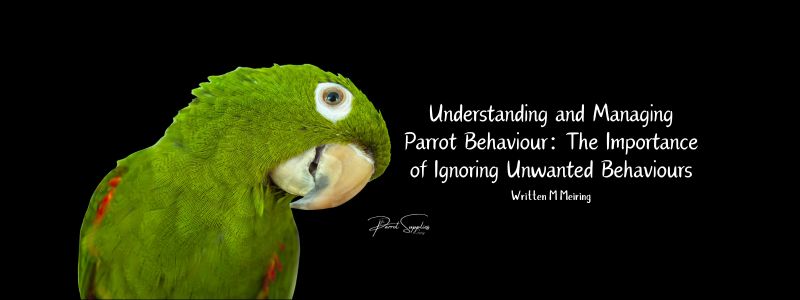Understanding and Managing Parrot Behaviour: The Importance of Ignoring Unwanted Behaviours
Parrots are highly intelligent creatures known for their vibrant personalities and ability to mimic human speech. This intelligence, however, also means they can develop complex behavioural issues if not managed correctly. A common challenge for many parrot owners is dealing with unwanted behaviours such as screaming, biting, or feather plucking. Addressing these issues effectively requires an understanding of parrot psychology and behaviour management strategies. One such strategy is the intentional ignoring of unwanted behaviours.
The Psychology Behind Ignoring Unwanted Behaviours
Ignoring unwanted behaviours in parrots is based on the principle that even negative attention can reinforce these behaviours. Parrots, much like humans, seek attention from their peers and caregivers. When a parrot exhibits an undesirable behaviour, any form of attention directed towards them, whether positive or negative, could be interpreted as a reward. Research in avian behaviour suggests that parrots are less likely to repeat a behaviour if it does not yield attention or a desirable outcome (Ackerman, 2016).
For instance, if a parrot begins screaming for attention and is consistently ignored, it gradually learns that screaming does not achieve the desired effect of engaging its owner. This is aligned with findings from a study by Peckre et al. (2019), which observed that African Grey Parrots could adapt their social interactions based on the attention outcomes of previous actions.
Practical Application in Daily Interaction
The application of ignoring as a strategy should be consistent and combined with the reinforcement of positive behaviours. This approach is known as "differential reinforcement of other behaviour" (DRO). It involves ignoring the bad behaviour while simultaneously rewarding the parrot when it engages in acceptable behaviour. For example, if a parrot remains quiet during a time it typically screams, this good behaviour should be rewarded with attention or treats (Friedman, 2005).
It's essential to ensure that the parrot's environment is enriched and that it has plenty of stimulation. A lack of mental and physical stimulation can lead to boredom, which often exacerbates behavioural issues. Regular interaction, toys, puzzles, and training sessions are vital in providing a stimulating environment that discourages negative behaviours by fulfilling the parrot's intellectual needs (Jones, 2018).
Challenges and Considerations
While ignoring unwanted behaviours can be effective, it's crucial to apply this strategy correctly. Sudden withdrawal of attention without understanding the cause of the behaviour might lead to stress and anxiety in parrots. Therefore, it's important to ascertain that the bad behaviour is not a result of underlying health issues or environmental stressors. Regular check-ups with an avian vet and observations on changes in the living environment are recommended to ensure that the behaviour is purely attention-seeking and not a sign of a deeper issue.
Additionally, some behaviours that are dangerous or destructive require immediate intervention rather than being ignored. In these cases, consulting with an avian behaviourist to find the appropriate training techniques and modifications is advisable.
Conclusion
Ignoring unwanted behaviours in parrots can be a useful technique within a broader behavioural management strategy. By understanding the psychological motivations behind these behaviours and applying consistent, thoughtful techniques, parrot owners can foster a more harmonious and enjoyable relationship with their feathered friends. As with any training technique, patience and consistency are key, coupled with a nurturing and enriching environment that meets all of a parrot's physical and psychological needs.
References
- Ackerman, L. (2016). The Parrot Companion. Caring for Parrots, Understanding Their Needs and Behaviour.
- Peckre, L., et al. (2019). "Effectiveness of Different Training Techniques in Parrots." Journal of Avian Medicine and Surgery.
- Friedman, S. G. (2005). "The Effects of Positive Reinforcement on Non-vocal Communication in Parrots." Behavioural Processes.
- Jones, S. (2018). "Environmental Enrichment for Captive Birds." Pet Behaviour Science.

